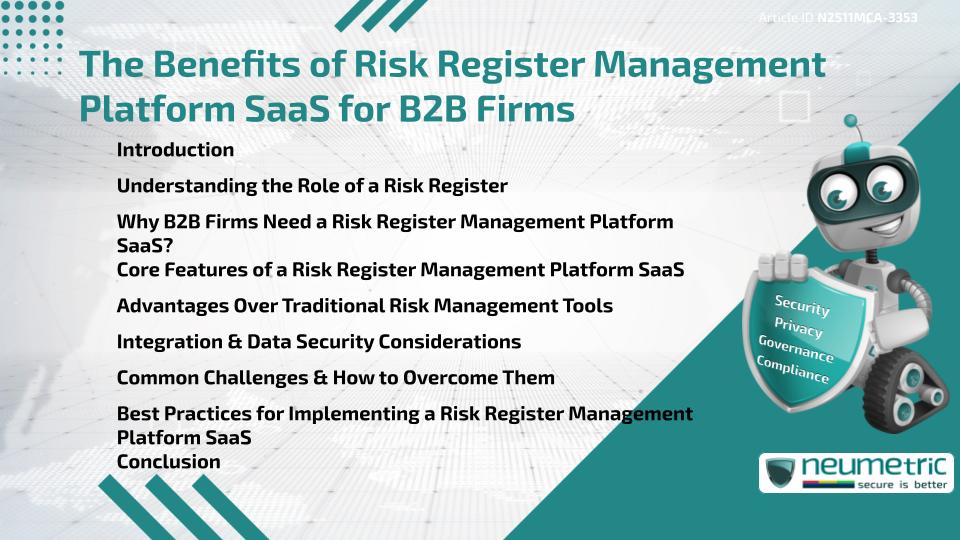Table of Contents
ToggleIntroduction
A Risk Register Management Platform SaaS provides B2B firms with a unified digital solution to identify, assess & monitor organisational Risks efficiently. It centralizes all Risk-related data in a single system, enhances visibility across departments & enables real-time collaboration. By adopting a cloud-based SaaS model, firms benefit from scalability, automatic updates & reduced maintenance costs. This article explores how such platforms transform enterprise Risk Management, the challenges they address & practical ways to implement them successfully.
Understanding the Role of a Risk Register
A Risk register serves as the foundation for structured Risk Management. It documents identified Risks, their likelihood, potential impact & mitigation measures. Traditionally, companies relied on spreadsheets or static databases to track these elements. However, such manual approaches often lead to inconsistencies & version control issues.
In contrast, a Risk Register Management Platform SaaS automates this process, ensuring continuous Data Integrity, easy accessibility & accurate reporting. Platforms like these streamline updates & enhance accountability across business units.
Why B2B Firms Need a Risk Register Management Platform SaaS?
B2B firms operate in complex environments involving supply chain dependencies, regulatory pressures & Client commitments. A centralized SaaS platform ensures that decision-makers have a comprehensive view of all enterprise Risks.
Key reasons why B2B firms adopt these platforms include:
- Improved transparency across departments & partners.
- Faster Risk identification through automated alerts.
- Simplified compliance reporting aligned with Frameworks like ISO 31000 or SOC 2.
- Enhanced collaboration for geographically distributed teams.
Such benefits help businesses anticipate Threats, reduce operational disruptions & meet Client expectations more effectively.
Core Features of a Risk Register Management Platform SaaS
Modern platforms offer diverse functionalities that go beyond simple Risk tracking. Core features often include:
- Customizable dashboards that visualize real-time Risk metrics.
- Automated workflows for approvals & escalation processes.
- Audit trails that maintain historical Risk records.
- Integrations with CRM, ERP & project management systems.
- Role-based Access Controls for Data Security & Governance.
These features make the Risk Register Management Platform SaaS not just a repository but a decision-making tool that supports enterprise resilience.
Advantages Over Traditional Risk Management Tools
Unlike traditional spreadsheets or on-premise software, SaaS solutions offer flexibility, scalability & accessibility. Users can access Risk data from any location with internet connectivity. Automatic software updates ensure compliance with emerging Standards without manual intervention.
Moreover, SaaS platforms typically feature advanced analytics that detect trends & anomalies in real-time. This predictive capability empowers Risk managers to act proactively rather than reactively.
Integration & Data Security Considerations
Integrating a Risk Register Management Platform SaaS into existing IT ecosystems is a strategic advantage. Platforms are designed to integrate seamlessly with tools like Microsoft 365, Salesforce or SAP, creating a unified Risk intelligence network.
However, Data Security remains a critical concern. Leading vendors implement encryption protocols, role-based access & compliance with Standards such as GDPR & ISO 27001. Resources like CSO Online provide insights into secure SaaS adoption strategies for enterprises.
Common Challenges & How to Overcome Them
Despite the advantages, Organisations often face hurdles during adoption. Common challenges include User resistance, data migration issues & insufficient training.
To overcome these, firms should:
- Conduct phased rollouts to ease transition.
- Offer continuous User training & support.
- Align platform configurations with existing business processes.
Adhering to these steps minimizes disruptions & promotes long-term system adoption.
Best Practices for Implementing a Risk Register Management Platform SaaS
Successful implementation requires a strategic approach. Start by mapping current Risk processes & identifying integration touchpoints. Assign a cross-functional implementation team to oversee configuration & testing.
regular Audits & system reviews also help optimize performance & ensure that the tool evolves with organizational needs.
Conclusion
A Risk Register Management Platform SaaS equips B2B firms with a comprehensive, scalable & secure approach to enterprise Risk Management. It streamlines processes, improves collaboration & supports compliance while reducing operational inefficiencies. As Risk landscapes continue to evolve, such platforms provide a resilient Framework for decision-making & accountability.
Takeaways
- SaaS platforms centralize & automate Risk Management.
- Enhanced analytics & dashboards improve decision-making.
- Data Security & compliance are integral to implementation.
- Effective training & phased rollouts ensure success.
FAQ
What is a Risk Register Management Platform SaaS?
It is a cloud-based application that helps Organisations document, monitor & manage Risks in a centralized system.
How does it benefit B2B firms?
It enhances collaboration, automates workflows & supports compliance across multiple departments.
Is data secure in a SaaS platform?
Yes. Leading providers use encryption, Access Controls & compliance Standards like GDPR & ISO 27001.
How difficult is implementation?
Implementation varies by organisation size but can be simplified through phased rollouts & User training.
Can it integrate with existing software?
Most SaaS platforms integrate easily with popular business tools like CRM & ERP systems.
What makes it better than spreadsheets?
It ensures real-time updates, version control & automation-features not available in manual systems.
Who should manage the platform?
Risk officers, compliance managers or designated system administrators typically oversee platform operations.
Need help for Security, Privacy, Governance & VAPT?
Neumetric provides organisations the necessary help to achieve their Cybersecurity, Compliance, Governance, Privacy, Certifications & Pentesting needs.
Organisations & Businesses, specifically those which provide SaaS & AI Solutions in the Fintech, BFSI & other regulated sectors, usually need a Cybersecurity Partner for meeting & maintaining the ongoing Security & Privacy needs & requirements of their Enterprise Clients & Privacy conscious Customers.
SOC 2, ISO 27001, ISO 42001, NIST, HIPAA, HECVAT, EU GDPR are some of the Frameworks that are served by Fusion – a SaaS, multimodular, multitenant, centralised, automated, Cybersecurity & Compliance Management system.
Neumetric also provides Expert Services for technical security which covers VAPT for Web Applications, APIs, iOS & Android Mobile Apps, Security Testing for AWS & other Cloud Environments & Cloud Infrastructure & other similar scopes.
Reach out to us by Email or filling out the Contact Form…


